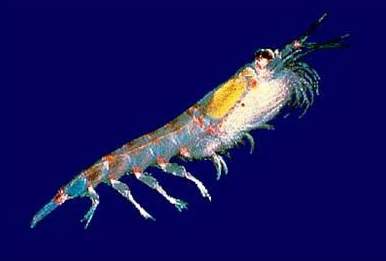Deep-sea krill discovered in Antarctica
Deep-sea krill discovered in Antarctica
mongabay.com
February 25, 2008
|
|
Antarctic krill have been found living at depths up to 3000 meters near the Antarctic Peninsula, a finding that changes scientists’ understanding of a fundamental part of the ocean food chain. Previously researchers believed that krill lived only in the upper ocean.
“While most krill make their living in the ocean’s surface waters, the new findings revise significantly our understanding of the depth distribution and ecology of Antarctic krill. It was a surprise to observe actively-feeding adult krill, including females that were apparently ready to spawn, close to the seabed in deep water,” said Professor Andrew Clarke of the British Antarctic Survey, which along with the National Oceanography Centre-Southampton, conducted the research using a remotely operated vehicle (RoV).
 Krill. Photograph courtesy of NOAA’s National Marine Sanctuary |
“Having the ability to use a deep-water ROV in Antarctica gave us a unique opportunity to observe the krill and also to observe the diversity of animals living at the deep-sea floor from depths of 500m down to 3500m. The importance of such observations is that, not only do we have the ability to identify species, but we can see the relations among individual species and their relationship to the ambient environment,” added Professor Paul A Tyler of the National Oceanography Centre-Southampton
The researchers say the discovery provides an important lesson for marine research.
“The behaviour of marine organisms – even quite ‘primitive’ ones – can be complex and more varied than we usually assume,” said Clarke. “There is still a great deal to learn about the deep sea and an important role for exploration in our attempts to understand the world we live in.”
In the Antarctic, Krill are an important food source for whales, seals, penguins, squid, and fish. In the Southern Ocean the Antarctic Krill makes up a biomass of over 500 million tons, roughly twice that of humans, according the Wikipedia.
The research is published in the journal Current Biology.